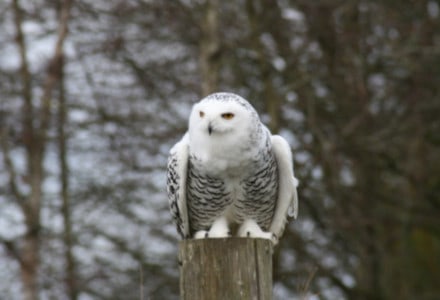
Snowy Owl Facts
- Firstly, the truly magnificent Snowy Owl ranks as comparatively large, in relation other species of owl. This remarkable fact occurs despite the relative harshness of its native habitat. The magnificent animal further remains easily recognized for its distinctive features.
- The gorgeous animal also goes by the scientific name of Bubo scandiacus Regardless of the term used, this amazing bird also stands out for its sheer physical size. This holds true due to the fact that the animal constitutes one of the largest known species of owl.
- In addition, on average, individuals also commonly rank as the heaviest owl species, as well. This impressive statistic only serves to further enhance its sheer awesomeness. Sadly, though, the Snowy Owl ranks as Vulnerable, on the IUCN Red List.
- Finally, the animal also possesses numerous evolutionary adaptations. These most notably include such factors as relatively thick plumage, heavily feathered feet with claws, and distinctive color patterns. These render it well-adapted for life north of the Arctic Circle.
Related Articles
Bald Eagle Brown Pelican Crowned Eagle
Snowy Owl Physical Description
Perhaps most notably, the eyes of the Snowy Owl provide an incredibly striking visual appeal. In point of fact, these most commonly display a brilliant shade of yellow. This distinctive feature contrasts quite sharply with the black beak and white feathers the bird also possesses.
The bird also displays a moderate degree of the trait of sexual dimorphism. Most adult males appear virtually pure white, but females and young birds have some dark markings. A young member of the species also appears heavily barred, and dark spotting may even predominate.
The beautiful Snowy Owl achieves some impressive measurements. That holds true due to the fact that mature adults sometimes reaches a body length of as much as 28 in (71 cm). Further, its wingspan may be up to 59 in (150 cm). Finally, individuals may weigh almost 6.6 lb (3 kg).
- Kingdom: Animalia
- Phylum: Chordata
- Class: Aves
- Order: Strigiformes
- Family: Strigidae
- Genus: Bubo
- Species: B. scandiacus
Snowy Owl Distribution, Habitat, and Ecology
The truly beautiful Snowy Owl nests in the Arctic tundra of the northernmost stretches of Alaska and Canada, in North America, and also Eurasia. Most also winter south through Canada and northern Eurasia, with a presence occurring further south in some years.
Most of the birds like open areas like coastal dunes and prairies that appear somewhat similar to tundra. The animals have been reported as far south as the American states of Texas, Georgia, the American Gulf states, southernmost Russia, and northern China.
The owl remains a very powerful animal for its size. It primarily preys on lemmings and other small rodents for food during the breeding season. However, at times of low prey density, or during the nesting period, it may switch to favoring juvenile ptarmigan.
The incredible birds also evolved as primarily opportunistic hunters. Typical prey for this species varies considerably, especially in winter. It therefore feeds on a comparatively wide variety of small mammals such as meadow voles and deer mice.
But, the Snowy Owl occasionally veers from this pattern. The powerful raptor sometimes takes advantage of larger prey as well. Some of the larger mammal prey includes hares, muskrats, marmots, squirrels, rabbits, raccoons, prairie dogs, rats, moles, and smaller birds.
Being flexible in its habits, the owl will also take fish from the surface of lakes. Each bird must capture roughly 7 -12 mice per day to meet its food requirement and can eat more than 1,600 lemmings per year. Like many other birds, the bird swallows its prey whole.
Snowy Owl Threats
Though Snowy Owls have few predators, the adults remain very watchful at all times. Further, the mature individuals have been blessed by Nature for self-protection. This holds true since each comes equipped to defend against any kind of threat towards them or their offspring.
During the nesting season, the impressive owls regularly defend the nests against any and all potential threats. These dangers include such predators as arctic foxes, corvids, and swift-flying jaegers. Other threats, however, include dogs, gray wolves and avian predators.
In addition, the males of the remarkably adapted species defend the nest. Consequently, these often act much like human sentries. This they accomplish by standing guard nearby, while the female incubates the vulnerable eggs and broods the young.
Additionally, both sexes of the awesome Snowy Owl readily attack approaching predators. This often occurs with great ferocity. This the animals accomplish by dive-bombing them and engaging in distraction displays to draw the predator away from a nest.
Species Sharing Its Range
Polar Bear Arctic Fox Wood Frog
Check out our other articles on 5 Incredibly Wonderful Trees, Japanese Spider Crab, Blood Falls, Eastern Diamondback Rattlesnake, Phallus Indusiatus, Pangolin

